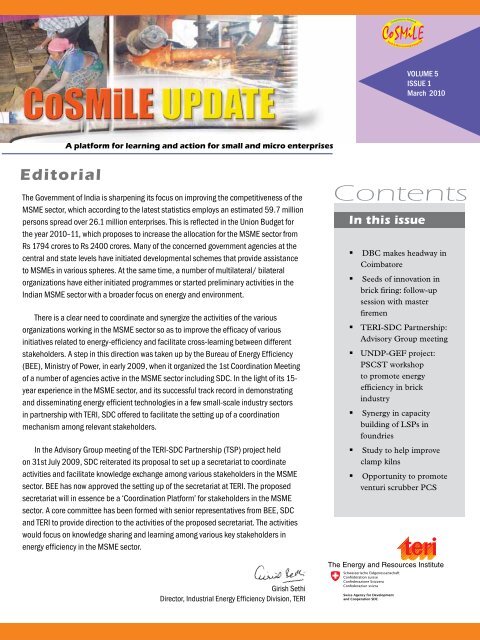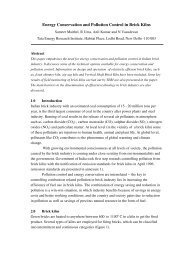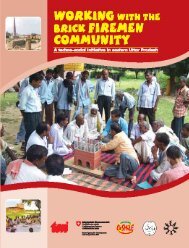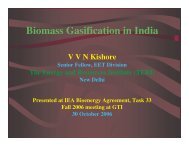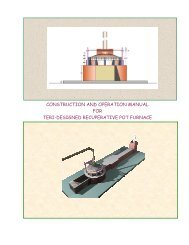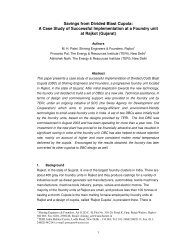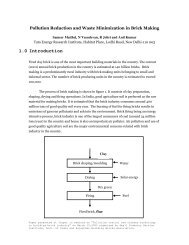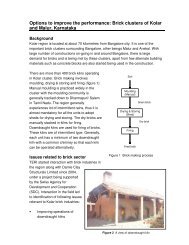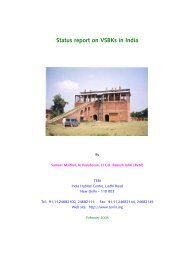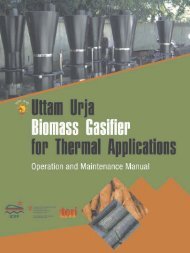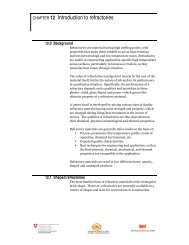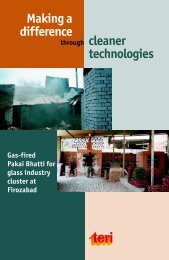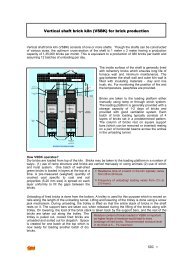Vol. 5, Issue 1, March 2010 - Cosmile.org
Vol. 5, Issue 1, March 2010 - Cosmile.org
Vol. 5, Issue 1, March 2010 - Cosmile.org
You also want an ePaper? Increase the reach of your titles
YUMPU automatically turns print PDFs into web optimized ePapers that Google loves.
VOLUME 5ISSUE 1<strong>March</strong> <strong>2010</strong>A platform for learning and action for small and micro enterprisesEditorialThe Government of India is sharpening its focus on improving the competitiveness of theMSME sector, which according to the latest statistics employs an estimated 59.7 millionpersons spread over 26.1 million enterprises. This is reflected in the Union Budget forthe year <strong>2010</strong>–11, which proposes to increase the allocation for the MSME sector fromRs 1794 crores to Rs 2400 crores. Many of the concerned government agencies at thecentral and state levels have initiated developmental schemes that provide assistanceto MSMEs in various spheres. At the same time, a number of multilateral/ bilateral<strong>org</strong>anizations have either initiated programmes or started preliminary activities in theIndian MSME sector with a broader focus on energy and environment.There is a clear need to coordinate and synergize the activities of the various<strong>org</strong>anizations working in the MSME sector so as to improve the efficacy of variousinitiatives related to energy-efficiency and facilitate cross-learning between differentstakeholders. A step in this direction was taken up by the Bureau of Energy Efficiency(BEE), Ministry of Power, in early 2009, when it <strong>org</strong>anized the 1st Coordination Meetingof a number of agencies active in the MSME sector including SDC. In the light of its 15-year experience in the MSME sector, and its successful track record in demonstratingand disseminating energy efficient technologies in a few small-scale industry sectorsin partnership with TERI, SDC offered to facilitate the setting up of a coordinationmechanism among relevant stakeholders.In the Advisory Group meeting of the TERI-SDC Partnership (TSP) project heldon 31st July 2009, SDC reiterated its proposal to set up a secretariat to coordinateactivities and facilitate knowledge exchange among various stakeholders in the MSMEsector. BEE has now approved the setting up of the secretariat at TERI. The proposedsecretariat will in essence be a ‘Coordination Platform’ for stakeholders in the MSMEsector. A core committee has been formed with senior representatives from BEE, SDCand TERI to provide direction to the activities of the proposed secretariat. The activitieswould focus on knowledge sharing and learning among various key stakeholders inenergy efficiency in the MSME sector.ContentsIn this issue• DBC makes headway inCoimbatore• Seeds of innovation inbrick firing: follow-upsession with masterfiremen• TERI-SDC Partnership:Advisory Group meeting• UNDP-GEF project:PSCST workshopto promote energyefficiency in brickindustry• Synergy in capacitybuilding of LSPs infoundries• Study to help improveclamp kilns• Opportunity to promoteventuri scrubber PCSThe Energy and Resources InstituteGirish SethiDirector, Industrial Energy Efficiency Division, TERI
DBC makes headway inCoimbatoreThe REEEP project focuses onimplementation of three energy efficiencyprojects in Coimbatore foundry cluster.Towards this, TERI is interacting with thelocal industry association and progressiveentrepreneurs for adopting energy efficientDBC technology. These efforts were rewardedwhen one of the most progressive metal castingunits in the cluster, Aquasub Engineering,showed interest in adopting DBC technology.This unit was earlier using an electricinduction furnace for melting metal.Based on the requirements of the unit,TERI prepared design drawings for two27-inch DBCs, which were fabricatedand installed at Aquasub by a Pune-basedfabricator. The TERI team successfullycommissioned the DBCs during the period9–11 <strong>March</strong> <strong>2010</strong>. The DBCs are performingwell and the temperature of molten metalis about 1400 °C. The quality of the moltenmetal was tested and found satisfactory bymaking sample moulds. The commissioningwas accompanied by hands-on training to theDBC commissioned at Aquasub Engineering, Coimbatorefurnace operators and workers on operationalprocedures, best practices and safety measures.Two more foundry units have beenidentified that are keen to adopt two DBCseach: (1) Eltex Super Cast and (2) NirmalPumps (a sister concern of CRI Pumps Ltd,which was the first unit in Coimbatore toadopt the TERI-design DBC).Seeds of innovation in brickfiring: Follow up session withmaster firemenAs reported earlier (see <strong>Cosmile</strong> Update 4(3),September 2009), TERI has been engagedin efforts to enhance the capacities of masterfiremen and firemen who work on brick kilns,through a participatory technical trainingprogramme. The programme comprisestwo phases: (1) classroom sessions and (2)field sessions. In the first phase, a total ofeight classroom sessions were conductedin eastern Uttar Pradesh (four each in RaeBareilly and Allahabad) covering over 200participants—mainly, master firemen. Thesesessions synergized traditional knowledge withscientific knowledge; they enabled the masterfiremen to share and discuss their traditionalknowledge, skills and operating practices, andto understand them better in the context ofscientific knowledge on brick-making andkiln firing techniques. In essence, the masterfiremen have been able to strengthen theirtraditionally acquired practical knowledgeof ‘how’ to make good bricks, with scientificinputs that have enabled them to understand‘why’ their traditional brick-making practiceswork. This deeper understanding hasempowered the master firemen to evolve anumber of innovations and improvements inkiln operation practices through discussionsand debate.In the second phase of the programme,TERI is observing and mentoring selectedmaster firemen at their kiln sites during thecurrent brick-making season (January–June<strong>2010</strong>). The objective is to find out how themaster firemen implement the improved/innovative practices that they have evolvedduring the training sessions, and to enable2
Follow-up with master firemen – Adalaj, Gujaratthem to evolve further improvements/innovations in practices where necessarythrough training in situ.In January <strong>2010</strong>, TERI observed andmentored a few master firemen in their brickkilns in Adalaj, near Ahmedabad in Gujarat.Major observations during the field visitincluded the adoption of improved operatingpractices by the master firemen mainly in threekey areas: (1) improved fuel feeding patterns,(2) control of heat leakages; and (3) improvedinsulation at the kiln top. While detailedstudies are required to quantify the exactbenefits of these improved practices (e.g.,in terms of fuel savings/energy efficiency),the kiln owners expressed their satisfactionwith the innovative practices being deployed.Furthermore, the trained master firemenare disseminating the knowledge of theseimproved practices to other firemen andworkers in their charge—as envisaged at thestart of this programme—thereby sowingthe seeds for capacity-building and furtherinnovation on a wider scale.TERI-SDC Partnership:Advisory Group meetingThe second Advisory Group meeting ofthe TERI–SDC Partnership (TSP) projectwas held on 12 th <strong>March</strong> <strong>2010</strong> at TERI. Theparticipants included representatives fromBEE, PCRA, UNIDO, MNRE, office of theDevelopment Commissioner, MSME (DC-MSME), TIFAC, and the GEF–World BankProgram. TERI provided a summary ofprogress made since the first Advisory Groupmeeting (held on 31 st July 2009), highlightingin particular TERI’s partnership with other<strong>org</strong>anizations—such as BEE, UNIDO, PCRA,REEEP, UNDP, and CPCB—that are engagedin improving energy efficiency in the MSMEsector. The group focused on finding ways tomainstream improved technologies for MSMEsand accelerate the pace of their adoption. Thefollowing important points were discussed:P There are about 400 energy intensiveMSME clusters in the country, of whichat present only about 10% (around 50clusters) are being covered by initiativesof different agencies. Under thecircumstances, government policiesmust play a key role in facilitating thepromotion and adoption of improvedtechnologies.P There is a paucity of technically competenthuman resources —for instance, agencieswho could identify and implement energyefficient solutions for MSME units. In thisregard, the activities of the TSP projectand that of the BEE-SME scheme relatedSafety session on use of natural gasGAIL and TERIjointly <strong>org</strong>anizedan ‘Interactivesession onnatural gas(NG) usage andsafety practicesfor Firozabadglass industries’ on 6 th <strong>March</strong> <strong>2010</strong> in the Firozabadglass cluster. The session was attended by about60 participants comprising owners of pot andtank furnace units as well as other small-scaleentrepreneurs such as muffle furnace operators.Mr B Barik, Deputy Manager (Fire & Safety), GAIL,Agra, provided details on various issues related tofire safety and firefighting, including the ‘anatomy’ ofa fire, different kinds of fires, methods to prevent orcontain fires, and various fire extinguishing systemsand their operation. Carbon dioxide type and/ordry chemical powder type fire extinguishers mustbe used to put out fires caused by NG. The sessionconcluded with a firefighting drill.3
to the strengthening of local serviceproviders (LSPs) in different clusters areexpected to play a significant role in thelong-run.P The Credit Linked Capital SubsidyScheme (CLCSS) of the Ministry ofMSME provides subsidy for technologyupgradation. More MSME units couldbe encouraged to avail of the benefitsunder CLCSS. However, it was felt thatthere is a need to expedite decisions onsubsidy claims by individual units. Thereis also need for flexibility in implementingsubsidy schemes—as in the case of ricemills in Bihar, which were encouragedto adopt biomass gasifiers for powerapplications by modifying existing subsidyschemes.P BEE confirmed its support to TERI inundertaking a project in the Firozabadglass cluster, which would focus onsystems other than pot furnaces (as theseare being covered under the TSP project).P An estimated 100 new foundry unitswill be established in the upcomingindustrial park in Howrah cluster by theyear 2014, with a total installed capacity ofabout one million tonnes. It was felt that itis important to integrate energy efficiencyaspects at the technology design stage itselfto ensure that these new foundry unitsoperate at highest possible efficienciesfrom day one.P R&D based technology solutions mustbe evolved at local level by working alongwith local institutions. An example is theAhmedabad foundry cluster, where TERIhas worked closely with GITCO as wellas helped build the capacities of an LSP(a local fabricator) in order to provideenergy-efficient solutions for local foundryunits—namely, small size (18 inch) DBCs.UNDP-GEF project: PSCSTworkshop to promote energyefficiency in brick industryA workshop titled ‘Energy efficiencyimprovements in Indian brick industry’was <strong>org</strong>anized at Bathinda, Punjab on 19 thFebruary <strong>2010</strong> by the Punjab State Councilfor Science and Technology (PSCST) incollaboration with the Bathinda Brick KilnOwners Association. PSCST is one of theLocal Resource Centres (LRCs) under theongoing UNDP–GEF project to promote newand improved technologies for encouragingthe manufacture and use of resource-efficientbricks (REBs) in the country. The aim of theworkshop was to sensitize the brick fraternityabout the UNDP–GEF project and thebenefits likely to accrue from it. The eventwas attended by about 150 brick kiln owners,mainly from the districts of Bathinda, Muktsar,Mansa, Barnala, Ferozepore and Ludhiana,along with office bearers of district-levelassociations from all the districts of Punjab.Mr Paramjit Singh Sandhu, President,Bathinda Brick Kilns Owners Associationurged fellow brick kiln owners to exploremechanization of certain processes so as toimprove brick quality and reduce losses.Mr M S Jaggi, Director (PSCST) stressed thepotential benefits for brick entrepreneurs inadopting new and efficient technologies formanufacturing REBs such as hollow bricksand perforated bricks. REB manufacturewill also reduce the consumption of preciousraw materials like clay and fuel. Mr A KBanerjee from Walter Craven Ceramic Projects(India) Ltd—which has set up a modernplant to manufacture REBs in Uttarpara,(near Kolkata)—elaborated on the plant’stechnologies.Mr Rakesh Johri, Senior Fellow, TERIexplained how in Europe and other developedcountries, manufacturers as well as end-Workshop on REBs, Bathinda4
users have facilitated the transition fromconventional solid bricks to perforated/ hollowbricks. For the existing small brick kiln ownersin India, this transition will take place in stagesand be driven by three major factors: (1)shortage of manpower (2) demand for betterquality products (3) shortage of raw materials.He observed that 12 REB demonstration unitswould be set up in the country. The projectis also coordinating with the Bureau of IndianStandards (BIS) for establishing standards forREBs, and with state PWDs, CPWD, MESand other <strong>org</strong>anizations for incorporating thenecessary specifications in their guidelines forthe use of REBs.Mr Pritpal Singh, Senior Engineer,PSCST observed that brick producers mustshift their focus from increasing quantity(production volume) towards increasingquality (better product). He explained howREBs bring indirect benefits to the enduser—interms of energy saving and reducedcosts of plastering—and urged brick kilnowners to investigate their soils and seewhether they could be used to make REBsthrough mechanization. As LRC, PSCSTwould help the industry in identifying suitabletechnologies specific to the cluster needs,creating awareness on REBs among architectsand builders, and facilitating availabilityof loans for technology upgradation. It isimportant for existing brick producers to movequickly in this regard, as new players includingmulti-nationals have already started to enterthe market.Synergy in capacity building ofLSPs in foundriesUnder the REEEP-supported project forpromotion of DBC in the Coimbatore foundrycluster, a key component is to build capacitiesat cluster-level. This entails strengtheningthe capabilities of local service providers(LSPs) – fabricators and technicians – ininterpretation of design drawings, fabricationof equipment with strict quality norms,system commissioning, and maintenance andtroubleshooting.TERI worked with APITCO Ltd (aconsultancy <strong>org</strong>anization implementing aFinding the right LSPTERI’s search for an LSP in Coimbatorebegan a decade ago, when it commissioneda DBC—the first TERI-design DBC to beadopted in Coimbatore—at CRI Pumps Ltdwith the assistance of Mr Appassamy, alocal consultant. Recently, Mr Appassamysuggested that Mr Naagendiran, proprietorof a fabrication unit named SaravanaEngineering Work, could be an effectiveLSP for promoting the TERI-design DBC.TERI interacted with Mr Naagendiran andlearned that he had already fabricated andinstalled a DBC (broadly based on the TERIdesign) in a Coimbatore foundry namedAmma Alloy. Mr Naagendiran further provedhis mettle by fabricating a DBC based ondrawings given to him by TERI, and installingand commissioning it at Nelcast, a foundryunit near Chennai. A qualified mechanicalengineer, Mr Naagendiran has over 18 years’experience in fabrication of equipment andmachinery such as boilers, cupolas, andpollution control systems. As TERI’s LSP he islikely to play a key role in promoting the DBCin the Coimbatore cluster.SIDBI-supported project to promote businessdevelopment services in the Coimbatorecluster) in order to evolve a plan and structurefor LSP training programs. TERI held initialdiscussions with entrepreneurs and LSPson 27 th January <strong>2010</strong> in the cluster. Theprogram was attended by around 20 LSPs andrepresentatives from COSMAFAN MarketingLSP training program, Coimbatore5
Society (an association of foundry units thatarranges raw material supplies to its memberfoundries)and IIF (Institute of IndianFoundrymen).TERI conducted the technical sessionsof the training program. The first sessionincluded a general description of the DBCand its advantages vis-à-vis the conventionalcoke-based cupola. The second sessionfocused on the characteristics of the TERIdesignDBC and on issues relevant tofabrication of the DBC and related systemssuch as accurate interpretation of designdrawings, oxy-acetylene welding for castings,and so on. This joint training was in effecta synergy of capacity building initiativesat cluster level by different <strong>org</strong>anizations:APITCO, REEEP, SDC, SIDBI, and TERI.More such synergetic initiatives are envisagedin future.Study to help improve clamp kilnsTERI has initiated a project to monitor theperformance of different types of clamp kilnsin India. The study is being supported by theCentral Pollution Control Board (CPCB). Theaim is to help evolve and implement betterdesign and operating practices for improvingtheir environmental and energy performance.The objectives of the study are to:Tips on fast firing for energy efficiency inbrick and tile industryMr K C Thomas, proprietorof Thomson Tile Factory,Annallur, Kerala is aprogressive entrepreneur, whohas implemented a number ofenergy conservation measuresat his factory. These measureshave brought significantenergy savings and reduced productioncosts. The unit has earned EnergyConservation Awards for the years 2002-03and 2003-04 from the Energy ManagementCentre, Kerala for these efforts. Themeasures include the following features.P Hot flue gases from the fired chamber inthe kiln are sucked through blowers intothe dryer rooms or drying chamber forremoval of moisture from green bricks.P The flue gases at about 80–90 o C areused in chamber dryers and hot floordryers, wherein the waste gases arecooled to almost ambient conditions.P Use of stiff extrusion for brick makinghelps in reducing the water content ofclay to 15–18% thereby reducing thedrying time and improving the productquality.Clamp kiln, Gujarat6
P Prepare an inventory of clamp kilnsP Study and monitor the existing firingpractices, emissions and ambient air qualitylevels of different types of clamp kilnsP Develop cost-effective modifications andimproved operating practices and undertakedemonstrationsP Evolve emission standards for differenttypes of clamp kilnsTERI has approached various statepollution control boards (SPCBs) with arequest to collate information relatated toclamp kilns. Discussions were also heldwith office bearers of the Gujarat BrickManufacturers’ Federation, Ahmedabad. Afield visit was undertaken to the Adalaj brickindustry cluster to interact with local clampoperators and identify logistical requirementsfor environmental monitoring planned inApril/ May <strong>2010</strong>.Opportunity to promote venturiscrubber for pollution controlTERI participated in a workshop on‘Environmental sustainability in foundry andelectroplating sectors’ which was <strong>org</strong>anizedby the Tamil Nadu Pollution Control Board(TNPCB) on 11–12 February <strong>2010</strong> in theCoimbatore foundry cluster, which has around680 units. The event, which was attended byaround 200 participants, took place in thebackdrop of growing concerns about pollutionfrom coke-burning cupolas, because of whichTNPCB is strictly enforcing environmentalregulations in the cluster. While large-sizefoundry units have switched over to electricalinduction furnaces, a huge number of smallerfoundry units are not able to afford such aswitchover and continue to operate coke-basedcupolas. TNPCB is concerned over the fact thatthese smaller units are unable to comply withpollution control norms, as they have installedsub-optimal pollution control systems (PCS).During the workshop, the smaller cokebasedcupola entrepreneurs discussedthe problems they are facing in meetingenvironmental norms. A number of them wereinterested in learning more about the highefficiencyventuri scrubber system developedand demonstrated in Howrah foundry clusterunder the TERI-SDC Partnership project.Following the workshop, TERI along withTNPCB held focused discussions withinterested entrepreneurs who were provideddetails about the venturi scrubber system andits proven ability to meet the most stringentenvironmental norms. It was agreed thatrepresentatives from the cluster would visitHowrah to witness the venturi scrubber systemin operation. TNPCB also responded positivelyto the suggestion of demonstrating the venturiscrubber in the Coimbatore cluster.Venturi scrubber system, Howrah7
Divided blast cupolaGas-fired mufflefurnaceVertical shaftbrick kilnGas-fired pot furnaceBiomass based powergasifierGasifier for namkeen makingGasifier-baseddyeing unitFor more details, please contactGirish SethiProject Coordinator – CoSMiLEIndustrial Energy Efficiency DivisionTERI, Darbari Seth BlockIHC Complex, Lodhi RoadNew Delhi – 110 003, IndiaTel. +91 112468 2100 or 4150 4900Fax +91 112468 2144 or 2468 2145E-mail cosmile@teri.res.inWeb http://www.cosmile.<strong>org</strong>


